![]()
![]()
![]()
Use LEFT and RIGHT arrow keys to navigate between flashcards;
Use UP and DOWN arrow keys to flip the card;
H to show hint;
A reads text to speech;
33 Cards in this Set
- Front
- Back
|
Discuss cholesterol synthesis:
|
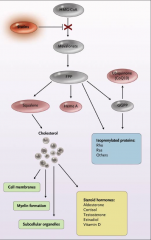
*Start with acetyl CoA.
*Rate limiting step is HMG-CoA reductase, which converts HMG-CoA to Mevalonate. *Note that Mevalonate also can become Inflammatory molecules (the Isoprenylated proteins)...statins may be anti-inflammatory for this reason. *Cardiovascular disease is increasingly being thought of as an inflammatory disorder. |
|
|
Discuss the 4 major lipoproteins:
|
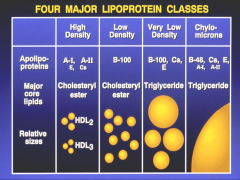
|
|
|
Discuss chylomicrons:
|
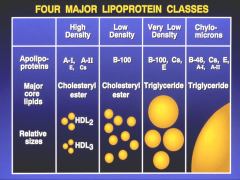
CHYLOMICRONS:
*Carry LOTS of TG. *ApoB48 (48% of gene is transcribed in intestines). *Have ApoCII, which activates lipoprotein lipase. *Delivers fat to the liver. |
|
|
Discuss VLDL:
|
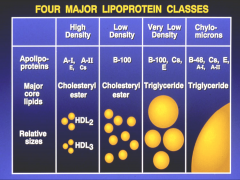
VLDL:
*Made in liver. Carry less TG than CMs, but still mostly TG. Carry a little bit of cholesterol. *ApoB100 (100% of gene is transcribed in the liver) is core protein. *Have ApoCII, which activates lipoprotein lipase. *Have ApoE, which gets rid of remnants. |
|
|
Discuss LDL:
|
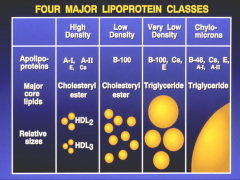
LDL:
*Metabolic products of VLDL. *Carry cholesterol esters almost entirely. *ApoB100 is core protein. Also acts as the ligand for the LDL receptor. |
|
|
Discuss HDL:
|
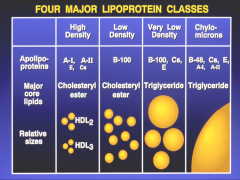
HDL:
*Made in both liver and intestines. *ApoA-I is core protein; functions as ligand for the HDP receptor. *Carries all cholesterol esters, which it delivers back to the liver. |
|
|
What are the 5 major apolipoproteins?
What Lipoproteins are they included in? Where are they synthesized? What is their function? |
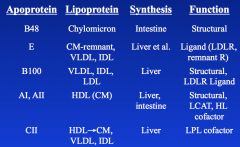
|
|
|
Discuss the exogenous pathway:
|
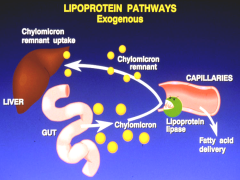
*Start with food--> CMs are made. They circulate, and their TGs are HYDROLYZED by LPL in the blood--> FFAs are taken up by cells that need energy; anything in excess is taken up by fat cells. CM remnants get taken up by liver; ApoE mediates the uptake of CM remnants.
*TGs will be elevated in diabetes; since insulin isn't activating LPL like it should. |
|
|
Major protein activator of LPL?
Major hormone activator of LPL? |
ApoCII
Insulin |
|
|
What's the purpose of FASTING lipid profiles?
When you get a fasting lipid profile, what particle are you measuring? When you get a total cholesterol, what particles are you measuring? 3 |
1) So CMs don't obscure the view of the real situation.
2) VLDL. 3) LDL (MOSTLY), HDL (some), VLDL (tiny bit). |
|
|
Discuss how LDL is made in the endogenous pathway:
|
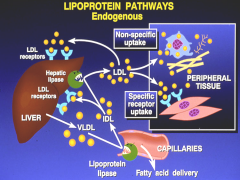
*AKA Hepatic pathway.
*CM remnants have delivered fat from diet to the liver. *Liver now makes VLVL around ApoB100 *VLVL goes into circulation, gets hydrolyzed by LPL. At this point, you've already absorbed everything and you're in a fasting state. Still, it needs LPL. So if you have diabetes, this is compromised. *LPL converts VLDL to IDL. *IDL starts to pick up cholesterol from HDL. This turns IDL into LDL. *So, LDL is made in the blood from hydrolysis of TGs in IDL and acceptance by IDL of CEs from HDL. |
|
|
Discuss the role of hepatic lipase in the endogenous pathway:
|
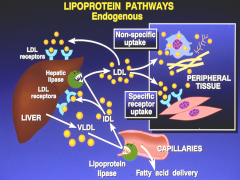
*Hepatic lipase: remodels IDL into LDL. It also remodels HDL. If hepatic lipase is overactive, it makes smaller, denser LDL particles, which are MORE atherogenic. Does the same thing to HDL--> HDL becomes small and gets excreted by the kidneys.
|
|
|
Discuss non-specific uptake in the endogenous pathway:
|
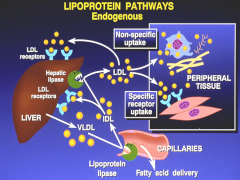
*Circulating LDL binds to LDLR on tissues that need cholesterol (testes, ovary, adrenal), or to LDLR on liver--> bile; or, it can undergo "non-specific uptake" by cells that don't need it (like vascular endothelial cells).
|
|
|
Effect of insulin on hepatic lipase?
|
It inhibits hepatic lipase! So if you have diabetes, your hepatic lipase is overactive. BAD--> small, dense, atherogenic LDL and low HDL levels.
|
|
|
Discuss cholesterol delivery via LDL:
|
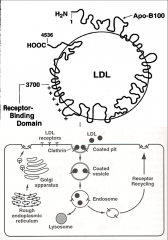
*LDL is derived from VLDL after lipase-mediated hydrolysis.
*Delivers cholesterol to tissues by ApoB100 binding to LDL receptor (LDLR), endocytosis via clathrin coated pits. The LDLR is recycled back to cell surface. *Modified LDL (e.g., oxidized) is taken up by macrophages (via scavenger receptors)--> foam cells in endothelial plaques. *Hepatic lipase (HL) acts on LDL to form small, dense LDL (bad...also jacks up HDL). |
|
|
What is Apo(a)? Why does it suck?
|
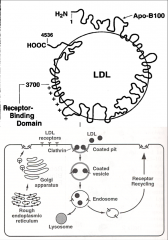
*Lp(a) is a modified LDL with Apo(a) linked to ApoB100.
*A part of its structure is homologous to plasminogen. It COMPETES with plasminogen (which is thrombolytic); thrombolysis isn't normal. Clots hang around too long. *This is a suspected mechanism by which Lp(a) contributes to CV disease. |
|
|
Mechanism behind Familial Hypercholesterolemia?
|
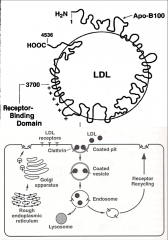
*In extreme mutations, you don't express the receptor at all.
*In some mutations, you express the receptor, but you don't recognize its ligand (ApoB100). *In some cases, you recognize ApoB100, but endocytosis is defective--> an enzyme degrades the receptor protein before it makes it back to the cell surface. |
|
|
Discuss the LDL receptor:
what does it do? what regulates its gene expression? what's the LDLR related protein? describe LDLR mutations. |
*Glycoprotein that binds ApoB100 (not ApoB48) and ApoE; ligand binding causes endocytosis.
*LDLR gene expression controlled by SREBP (also a transcription factor for HMG CoA Reductase). *LDL Receptor-Related Protein (LRP): large complex of 4 LDLR, binds and gets rid of ApoE-enriched particles (CM and VLDL remnants), not LDL (doesn't bind ApoB100!). *LDLR mutations: Familial Hypercholesterolemia; >40 mutations described. -5 phenotypes; AD, 1/500 (TC 250-500, LDL>180!). -AR or compound heterozygote, 1/106 (TC >500). |
|
|
Why can it be a problem that the LDLR binds both ApoB100 and ApoE?
|
ApoE can compete with B100. If you have too much ApoE, the LDLR isn't taking up enough LDL.
|
|
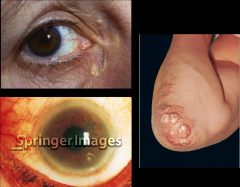
What are some dangers of really high LDL?
|

Top, right: Xanthomas.
Left, bottom: Arcus cornealis (yellow ring). *Seen in familial hypercholesterolemia. |
|
|
How does the liver get cholesterol:
in the baseline state? in a diet restriction state? while on a statin? |
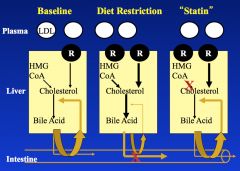
*On statin, LDLR expression is increased. LDL level decreases. But you can EAT around your statin. Cholesterol in diet still must be decreased.
|
|
|
Discuss the HDL reverse transport pathway:
|
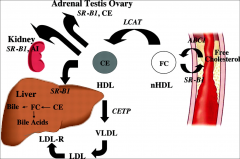
*Nascent HDL (nHDL) is formed with free cholesterol in the liver and intestines.
*nHDL becomes mature HDL by picking up free cholesterol from places where it shouldn't be (clean up). It does this via ABC1 and LCAT. LCAT converts free cholesterol to CEs. Now you have a mature HDL. *HDL takes cholesterol to places that need it, or it takes cholesterol back to the liver by binding SR-B1. |
|
|
Define:
FC-- CE-- LCAT-- nHDL-- ABC1-- SR-B1-- CETP-- HL-- |
*FC: free cholesterol.
*CE: cholesterol esters. *LCAT: Lecithin: cholesterol acyltransferase. -converts FC+ PL to CE *nHDL: nascent HDL. -Formed in intestines, liver: contains PL, ApoA1. -AKA preß-HDL: ready to accept FC-->CE by LCAT. *ABC1: ATP binding cassette transporter. -Transports FC out of cells to be picked up by HDL. *SR-B1: scavenger receptor B1 (“HDL” receptor). -Accepts CE from mature HDL after binding ApoA1. *CETP: CE transfer protein -“swaps” CE from HDL for lipids with VLDL-->LDL. *HL: Hepatic Lipase. -Acts on HDL to remove TG, PL, may increase clearance. |
|
|
Discuss Interpretation of a Fasting Lipid Profile:
|
1. Obtain fasting sample to eliminate chylomicrons (CM).
2. Total cholesterol (TC) and Triglycerides (TG) are measured directly: -TC largely indicates LDL. -TG indicate CM and VLDL. 3. HDL is measured directly after precipitation of Apo B100 containing lipoproteins (VLDL, IDL, LDL). 4. LDL in a standard lipid profile is an estimation, not a direct measurement. |
|
|
On a fasting lipid profile, how do you estimate LDL?
|
*Estimated LDL = TC - (HDL plus [TG/5]).
*TG/5 approximates VLDL cholesterol when TG < 400 mg/dl (best approximation when TG < 250 mg/dl). *If TG is 400 mg/dl or more, cannot use “Friedewald equation” as a “normal” [VLDL] is no longer likely. *Direct measurement by ultracentrifugation or LDL immunoprecipitation (special lab order). |
|
|
Calculate the LDL:
TC 193, TG 275, HDL 35 TC 208, TG 100, HDL 82 TC 324, TG 135, HDL 46 TC 248, TG 855, HDL 30 TC 203, TG 110, HDL 40 |
LDL = TC - (HDL plus [TG/5])
1. normal 2. normal 3. high 4. can't calculate; TG is too high. 5. |
|
|
What is the OLD Classification Scheme for Lipid Disorders: Lipoprotein Phenotype?
|

*Type I and Type V; LPL problem (high CMs).
*IIA; problem is LDLR. *IIB; problem is overproduction of VLDL. *III; problem is an ApoE problem. *IV; increased VLDL synthesis; HDL is low. |
|
|
Big list of Familial and Acquired Lipid Disorders:
|
*Familial:
-1˚Hypertriglyceridemia: Lipoprotein Lipase deficiency or Apo-CII deficiency. -Familial hypertriglyceridemia (FHTG) -Familial Dysbetalipo-proteinemia (RRD) -Familial Hypercholesterolemia (FH) -Familial Combined Hyperlipidemia (FCHL) -Polygenic hypercholesterolemia *Acquired: -Inflammatory illness -Obesity -Metabolic Syndrome -Diabetes -Hypothyroidism -Nephrotic syndrome/uremia -Obstructive liver disease -Storage diseases -Medications/alcohol -HIV protease inhibitors -Steroids |
|
|
Factors affecting LDL blood levels:
|
*Increased VLDL synthesis (dietary FFA; AD disorder 1/200: familial combined hyperlipidemia; polygenic familial hypertriglyceridemia).
*Down-regulation of LDLR (diet, FFA influx) . *Increased ApoE-containing particles that compete for the LDLR (familial dysbetalipoproteinemia/RRD). *Defective or decreased expression of LDLR (familial hypercholesterolemia). *Defective ApoB100 (similar to FH: 4 mutations known, AD, 1/500-1/750, milder disease). |
|
|
Summary diagram of major lipid disorders:
|
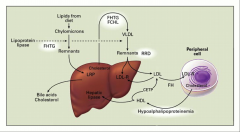
*RRD= remnant receptor disease.
|
|
|
Dyslipidemia of Diet and Obesity:
|
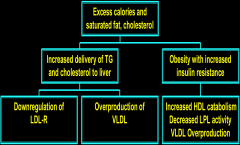
|
|
|
Disorders affecting HDL:
|
*Hypoalphalipoproteinemia:
-Defective/deficient ApoA1; AD. -Mild to severe forms: HDL <30mg/dl. *Tangiers Disease: -Defective ABC1 protein; AR. -Low LDL and HDL <10mg/dl. -Orange tonsils. *LCAT Deficiency/Fish Eye Disease: -Absent or defective LCAT enzyme; AR. -HDL <10mg/dl. *CETP deficiency: elevated HDL >100mg/dl. |
|
|
What’s the Dx?
TC 193, TG 275, HDL 35: LDL 103 Dx? TC 208, TG 100, HDL 82: LDL 106 Dx? TC 324, TG 135, HDL 46: LDL 251 Dx? TC 248, TG 855, HDL 30: LDL ??? Dx? TC 203, TG 110, HDL 40: LDL 141 Dx? |
1) Metabolic syndrome, diabetes. TG a little high; HDL a little low.
2) No problem. Good HDL level accounts for "high" TC. 3) Familial hypercholesterolemia. 4) Polygenic hypertriglyceridemia; OR it's a non-fasting lipid profile, OR undiagnosed type II diabetes. 5) Polygenic hypercholesterolemia. |

